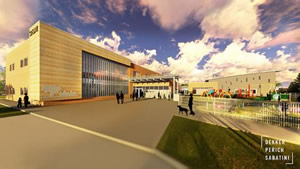Northern State University Receives Construction Grant
 Northern State University (NSU) in Aberdeen, SC, recently received a grant to support construction of a new School for the Blind and Visually Impaired on their campus. The new school is slated to occupy the space of a demolished hall and is being funded by grants from the Governor's Office of Economic Development Future Fund, the City of Aberdeen, and others.
Northern State University (NSU) in Aberdeen, SC, recently received a grant to support construction of a new School for the Blind and Visually Impaired on their campus. The new school is slated to occupy the space of a demolished hall and is being funded by grants from the Governor's Office of Economic Development Future Fund, the City of Aberdeen, and others.
The final designs for the School for the Blind and Visually Impaired emphasize efficiency and a sense of hominess for students. The classrooms in the building will benefit from improved lighting and amenities, while the rest of the facility features an upgraded pick-up/drop-off area, a kitchen, and a lounge area.
Construction of the new facility is part of NSU’s Educational Joint Impact Campaign, a campaign that is working to upgrade and construct multiple facilities and on campus. Construction on the facility is projected to be complete in the fall of 2019.